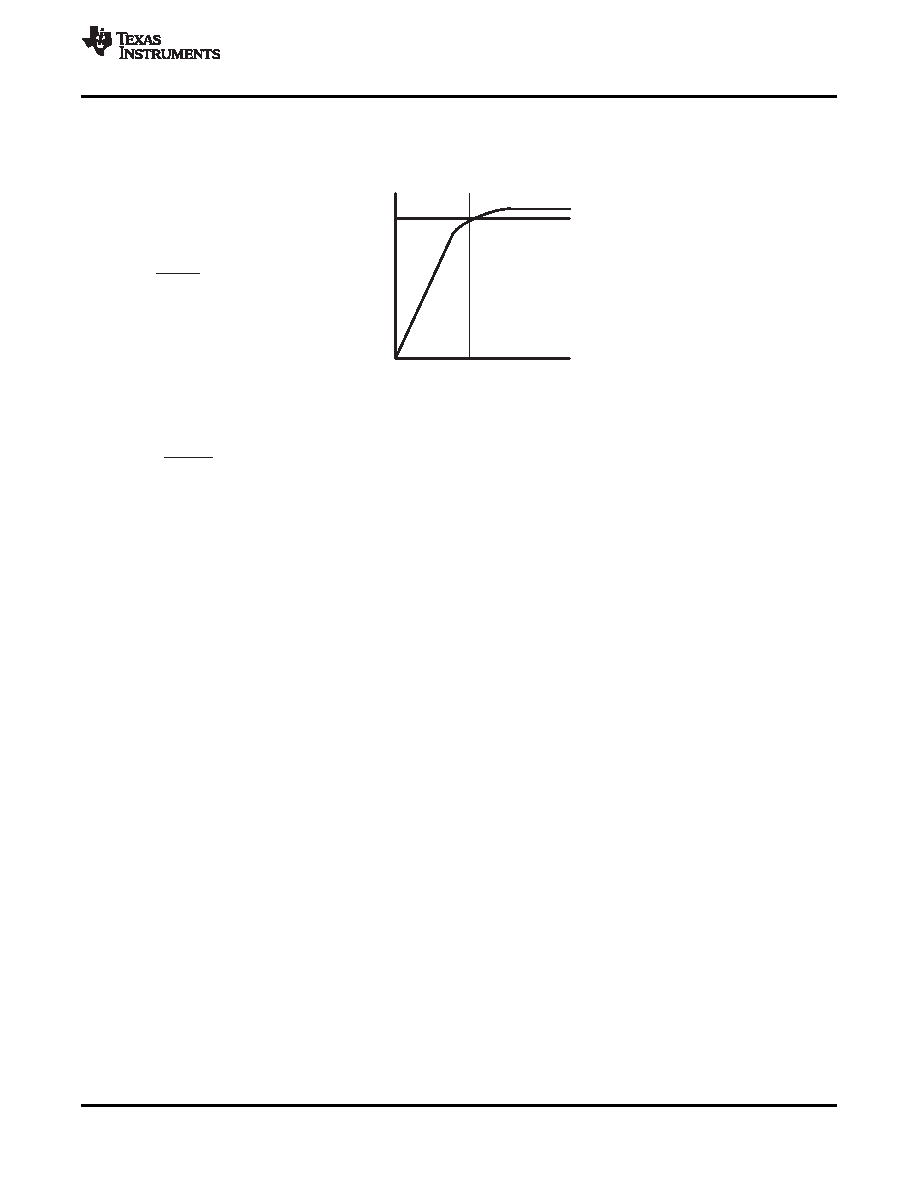- 您現(xiàn)在的位置:買賣IC網(wǎng) > PDF目錄98272 > TPA3008D2PHP (TEXAS INSTRUMENTS INC) 10 W, 2 CHANNEL, AUDIO AMPLIFIER, PQFP48 PDF資料下載
參數(shù)資料
| 型號: | TPA3008D2PHP |
| 廠商: | TEXAS INSTRUMENTS INC |
| 元件分類: | 音頻/視頻放大 |
| 英文描述: | 10 W, 2 CHANNEL, AUDIO AMPLIFIER, PQFP48 |
| 封裝: | GREEN, PLASTIC, HTQFP-48 |
| 文件頁數(shù): | 9/31頁 |
| 文件大?。?/td> | 654K |
| 代理商: | TPA3008D2PHP |
第1頁第2頁第3頁第4頁第5頁第6頁第7頁第8頁當(dāng)前第9頁第10頁第11頁第12頁第13頁第14頁第15頁第16頁第17頁第18頁第19頁第20頁第21頁第22頁第23頁第24頁第25頁第26頁第27頁第28頁第29頁第30頁第31頁

fc +
1
2 p Z
i
C
i
3 dB
fc
C
i +
1
2p Z
i fc
www.ti.com
SLOS435C – MAY 2004 – REVISED AUGUST 2010
INPUT CAPACITOR, CI
In the typical application, an input capacitor (Ci) is required to allow the amplifier to bias the input signal to the
proper dc level for optimum operation. In this case, Ci and the input impedance of the amplifier (Zi) form a
high-pass filter with the corner frequency determined in Equation 6.
(6)
The value of Ci is important, as it directly affects the bass (low-frequency) performance of the circuit. Consider
the example where Zi is 137 k and the specification calls for a flat bass response down to 20 Hz. Equation 6 is
reconfigured as Equation 7.
(7)
In this example, Ci is 58 nF; so, one would likely choose a value of 0.1 F as this value is commonly used. If the
gain is known and is constant, use Zi from Table 2 to calculate Ci. A further consideration for this capacitor is the
leakage path from the input source through the input network (Ci) and the feedback network to the load. This
leakage current creates a dc offset voltage at the input to the amplifier that reduces useful headroom, especially
in high gain applications. For this reason, a low-leakage tantalum or ceramic capacitor is the best choice. When
polarized capacitors are used, the positive side of the capacitor should face the amplifier input in most
applications as the dc level there is held at 2.5 V, which is likely higher than the source dc level. Note that it is
important to confirm the capacitor polarity in the application.
For the best pop performance, CI should be less than or equal to 1F.
Power Supply Decoupling,CS
The TPA3008D2 is a high-performance CMOS audio amplifier that requires adequate power supply decoupling
to ensure that the output total harmonic distortion (THD) is as low as possible. Power supply decoupling also
prevents oscillations for long lead lengths between the amplifier and the speaker. The optimum decoupling is
achieved by using two capacitors of different types that target different types of noise on the power supply leads.
For higher frequency transients, spikes, or digital hash on the line, a good low equivalent-series-resistance (ESR)
ceramic capacitor, typically 0.1 F placed as close as possible to the device VCC lead works best. For filtering
lower frequency noise signals, a larger aluminum electrolytic capacitor of 10 F or greater placed near the audio
power amplifier is recommended. The 10-F capacitor also serves as local storage capacitor for supplying
current during large signal transients on the amplifier outputs.
BSN and BSP Capacitors
The full H-bridge output stages use only NMOS transistors. Therefore, they require bootstrap capacitors for the
high side of each output to turn on correctly. A 220-nF ceramic capacitor, rated for at least 25 V, must be
connected from each output to its corresponding bootstrap input. Specifically, one 220-nF capacitor must be
connected from xOUTP to xBSP, and one 220-nF capacitor must be connected from xOUTN to xBSN. (See the
application circuit diagram in Figure 16.)
The bootstrap capacitors connected between the BSxx pins and corresponding output function as a floating
power supply for the high-side N-channel power MOSFET gate drive circuitry. During each high-side switching
cycle, the bootstrap capacitors hold the gate-to-source voltage high enough to keep the high-side MOSFETs
turned on.
Copyright 2004–2010, Texas Instruments Incorporated
17
Product Folder Link(s): TPA3008D2
相關(guān)PDF資料 |
PDF描述 |
|---|---|
| TPA3008D2PHPRG4 | 10 W, 2 CHANNEL, AUDIO AMPLIFIER, PQFP48 |
| TPA3008D2PHPG4 | 10 W, 2 CHANNEL, AUDIO AMPLIFIER, PQFP48 |
| TPA301DGNRG4 | 0.7 W, 1 CHANNEL, AUDIO AMPLIFIER, PDSO8 |
| TPA301DG4 | 0.7 W, 1 CHANNEL, AUDIO AMPLIFIER, PDSO8 |
| TPA301DGNG4 | 0.7 W, 1 CHANNEL, AUDIO AMPLIFIER, PDSO8 |
相關(guān)代理商/技術(shù)參數(shù) |
參數(shù)描述 |
|---|---|
| TPA3008D2PHPG4 | 功能描述:音頻放大器 10-W Stereo Class-D RoHS:否 制造商:STMicroelectronics 產(chǎn)品:General Purpose Audio Amplifiers 輸出類型:Digital 輸出功率: THD + 噪聲: 工作電源電壓:3.3 V 電源電流: 最大功率耗散: 最大工作溫度: 安裝風(fēng)格:SMD/SMT 封裝 / 箱體:TQFP-64 封裝:Reel |
| TPA3008D2PHPR | 功能描述:音頻放大器 10-W Stereo Class-D RoHS:否 制造商:STMicroelectronics 產(chǎn)品:General Purpose Audio Amplifiers 輸出類型:Digital 輸出功率: THD + 噪聲: 工作電源電壓:3.3 V 電源電流: 最大功率耗散: 最大工作溫度: 安裝風(fēng)格:SMD/SMT 封裝 / 箱體:TQFP-64 封裝:Reel |
| TPA3008D2PHPRG4 | 功能描述:音頻放大器 10-W Stereo Class-D RoHS:否 制造商:STMicroelectronics 產(chǎn)品:General Purpose Audio Amplifiers 輸出類型:Digital 輸出功率: THD + 噪聲: 工作電源電壓:3.3 V 電源電流: 最大功率耗散: 最大工作溫度: 安裝風(fēng)格:SMD/SMT 封裝 / 箱體:TQFP-64 封裝:Reel |
| TPA3009D2PHP | 制造商:Texas Instruments 功能描述: |
| TPA3009D2PHPR | 制造商:Texas Instruments 功能描述: |
發(fā)布緊急采購,3分鐘左右您將得到回復(fù)。